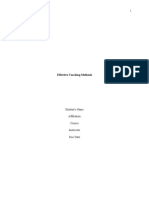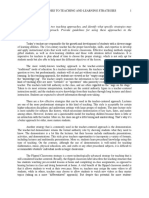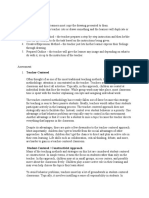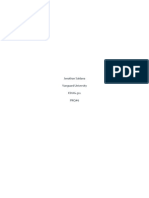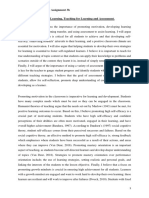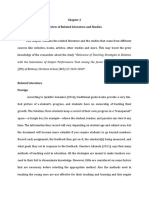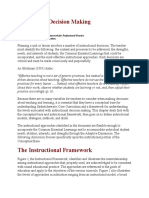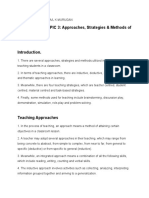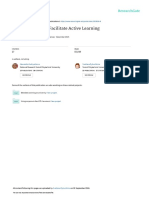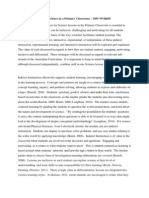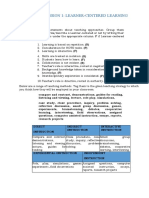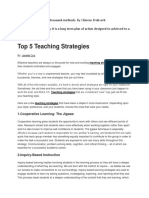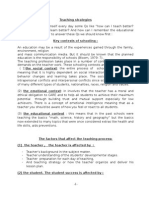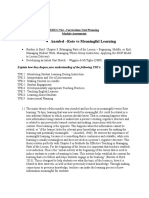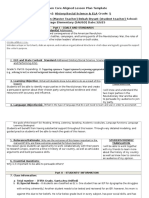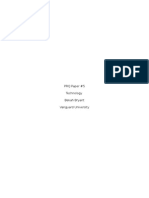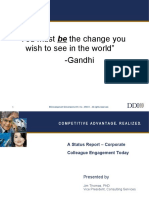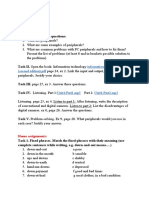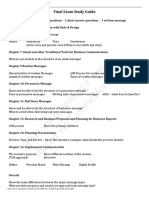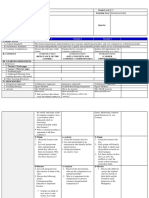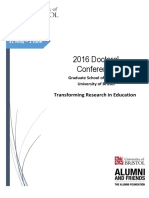RUNNING HEAD: PRQ 6 by Bekah Bryant
PRQ 6
Purpose & Value of Strategies, Activities, and Materials
Bekah Bryant
Vanguard University
�RUNNING HEAD: PRQ 6 by Bekah Bryant
Learning should not only take us somewhere; it should allow us later
to go further more easily. (Bruner, 1963) Through the use of carefully
chosen strategies, activities, and materials, teachers are able to make
learning transferrable in the classroom. In order to be an effective teacher,
one must be able to make the skills, knowledge, and concepts being taught
memorable and transferrable. That is students are able to use the general
skills and knowledge they have learned, and recognize the applicability of it
to a new situation or concept. This is the purpose and value of tactically
choosing a variety of strategies, activities, and materials that best suit our
students and will benefit them in the future.
The value of using different strategies, activities, and materials first
begins with the students in mind. The classroom is a diverse place that calls
for diversity in our teaching strategies in order to engage each student and
help them reach the academic goals asked of them. In chapter five of
Methods for Effective Teaching by Burden and Byrd, the value on
implementing these different strategies and activities is discussed: effective
teachers use many different strategies throughout a unit and the school year
as a means to differentiate their instruction and be more responsive to
student needs. (Burden & Byrd, 2013) Implementing direct, inductive,
social, and independent instructional approaches in the classroom all give
teachers the tool to differentiate their instruction for their students. Slower
learners may learn better from more direct instruction, while higher learners
may feel more challenged during an inductive lesson. This directly relates to
�RUNNING HEAD: PRQ 6 by Bekah Bryant
TPE 4.3 as it calls for the use of a variety of instructional strategies
according to purpose, lesson content, and student needs. (Commission on
Teacher Credentialing, 2013)
The purpose for using different strategies and the activities and
materials that coincide with these strategies vary. A direct instruction lesson
focuses primarily on the product to be gained from a specific lesson. Andrea
Guillaume, in K-12 Classroom Teaching, argues that inductive teaching
presents a stark contrast to direct instruction, (Guillaume, 2008) as it
focuses on the process by which knowledge is formed. The purpose for a
strategy that is teacher centered is usually to introduce new skills or
concepts in a relatively short period of time. They are academically focused,
with the teacher explicitly stating the goals of the lesson for the students.
The value of these types of strategies and activities are found in that
many students learn basic skills more rapidly when they receive the majority
of their instruction directly from the teacher. (Burden & Byrd, 2013) A
teacher may use a direct instruction strategy while teaching a lesson on
topic sentences. The teacher would explicitly state the definition of a topic
sentence, provide some sample sentences with the topic sentence circled for
students to see, then provide additional sentences that are missing topic
sentences and have the students write a topic sentence for each paragraph.
The teacher can review student work as a whole group and provide feedback
on student work. This method is direct, quick, and straightforward.
�RUNNING HEAD: PRQ 6 by Bekah Bryant
The purpose for a student-centered strategy and the activities involved
is found in the fact that these strategies allow students to become involved.
Students are involved through the process of discovery, asking questions and
answering those questions through experimentation and exploration. These
types of strategies involve activities that encourage students to construct
meaning out of the information they have been exposed to through active
engagement and investigation. This gives students the chance to work with
more hands-on materials than a direct instruction since students are testing
and experimenting with the materials around them to answer questions and
give meaning to their learning. (Burden & Byrd, 2013) A teacher may use an
inquiry approach to learning when exploring new ideas in science for
example. In the inquiry lesson I created for my second grade class, students
were simply shown materials, asked to observe the materials, create a
hypothesis about which item would roll the farthest and why, test the
materials, and find if their hypothesis was correct or incorrect. This gives
students the opportunity to ask questions and think for themselves. I am not
telling the students that the egg rolls farther than the pencil because it is
heavier, students are finding this out on their own.
These strategies discussed all lead to further understanding in our
students in the classroom. It is important to understand that each strategy
has its place, and as examined previously each has its value and purpose.
Without teacher-centered strategies, student-centered strategies would be
much more difficult for students to construct learning in. This ties into
�RUNNING HEAD: PRQ 6 by Bekah Bryant
Bruners theory of the importance of structure. He states that, What
learning general or fundamental principles does is to ensure that memory
loss will not mean total loss, that what remains will permit us to reconstruct
the details when needed. (Bruner, 1963) He also contests that teaching
specific topics or skills without previously making the broader context clear is
simply uneconomical. Students cannot participate in an inquiry lesson that
requires them to previously have basic knowledge to construct meaning out
of the little information given to them.
The more fundamental or basic is the idea he has learned, almost by
definition, the greater will be its breadth of applicability to new problems.
(Bruner, 1963) Students need the nonspecific transfer of knowledge of
principles and ideas in order to succeed in the classroom. This is the purpose
of implementing the variety of strategies, activities, and materials in a
classroom. Teaching students to use previously learned concepts, ideas, and
skills and apply them to a new situation or problem. Differentiating our
instruction in this manner helps keeps our teaching student minded, and will
be what creates an effective and lasting learning environment.
�RUNNING HEAD: PRQ 6 by Bekah Bryant
Works Cited
BRUNER, J. S. (1963). The process of education. Cambridge, Mass: Harvard University Press.
Burden, P. R., & Byrd, D. M. (2013). Methods for effective teaching. Boston: Allyn and Bacon.
California Teaching Performance Expectations. (2013). Retrieved March 29, 2016, from
http://www.ctc.ca.gov/educator-prep/standards/adopted-TPEs-2013.pdf
Guillaume, A. M., & Guillaume, A. M. (2004). K-12 classroom teaching: A primer for new
professionals. Upper Saddle River, NJ: Pearson/Merrill/Prentice Hall.
